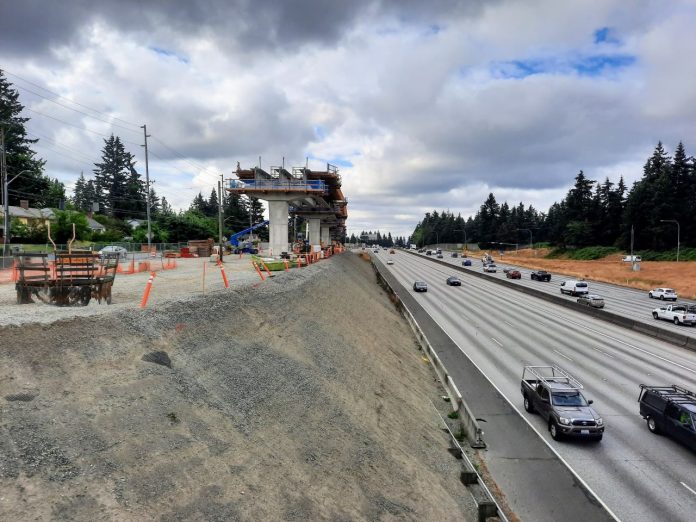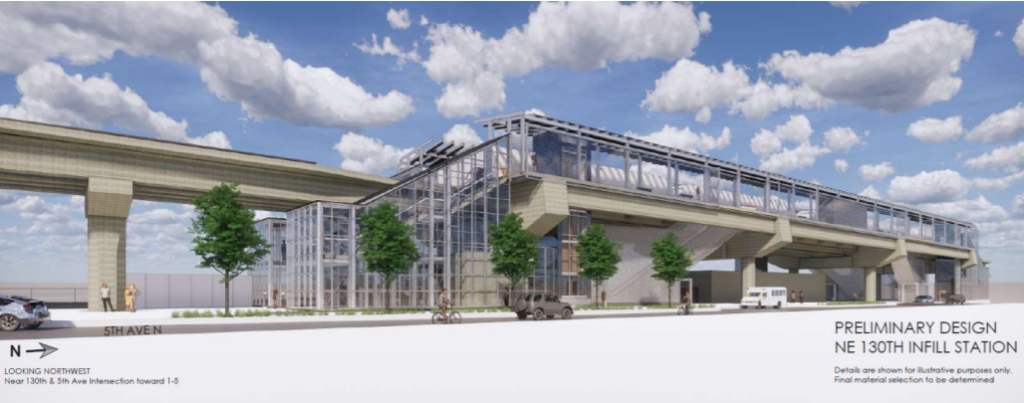Urbanists have been hoping that arrival of light rail to North Seattle would transform single-family sprawl oriented around I-5 and a 160-acre publicly-owned golf course to a dense neighborhood oriented around transit and accessible public green spaces.
On March 18th, the Seattle Office of Planning and Community Development (OPCD) released a 35-page draft plan for station area planning at 130th Street and 148th Street light rail stops. The draft plan didn’t settle many questions, such as how extensive the rezoning would ultimately be, how big future buildings could be, how to fund the mobility plan, and what the fate of the Jackson Park Golf Course would be. This minor milestone in the lengthy Seattle process means we’re likely three years out (maybe more) from passing station area plans and potentially rezoning these largely single-family areas. The one exception is the block across from 130th Street Station that the plan recommends for an earlier rezoning with an eye toward equitable transit oriented development and winning support for an early opening from the Sound Transit Board.
The City’s announcement stressed the 10-minute walkshed of the stations, but OPCD’s Patrice Carroll said the study area is wider than that, leaving more extensive changes on the table. A strict 10-minute walkshed could be pretty limiting, especially since the I-5 freeway trench cuts a gash right through the study area, spewing air and noise pollution in the vicinity. Reassurances aside, the current plan doesn’t seem to imagine significant zoning changes in the entire half-mile radiuses, let alone beyond it. Haller Lake and Olympic Hills could largely stay the same.
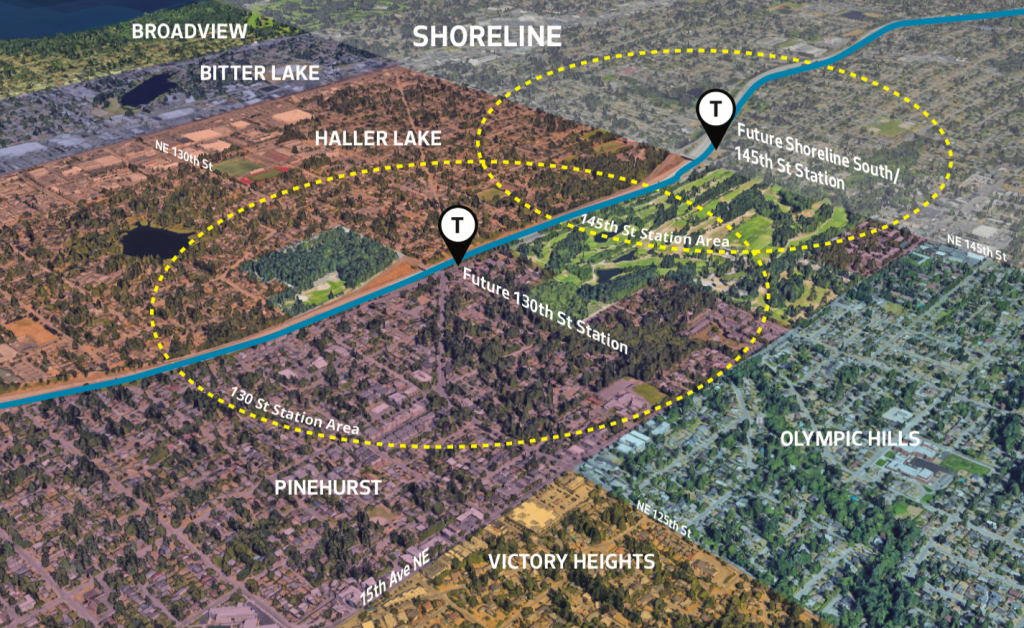
In his foreword to the draft plan, OPCD Director Sam Assefa made the case for designing complete neighborhoods, arguing the Covid pandemic had underscored the need.
“We have all been struggling during the devastating economic fallout from this disaster, and many of us have been directly impacted by illness or the loss of a loved one. The pain we are all feeling is very present and very real. In many ways, it makes a station area planning work like this seem less timely,” Assefa said. “And yet, something interesting is happening in our city. The number of commuters — by transit or by private vehicle — has fallen dramatically. Many of us are working or attending school from home. We are spending much more time in the neighborhood shopping and recreating. We begin to see more clearly the benefit of a complete neighborhood where we can meet our daily needs without the use of a car.”
“In that respect, this station area planning process could not be coming at a better time,” Assefa concluded. “This is our chance to imagine a transit-oriented community, better walking and biking connections.”
When will 130th Street Station open?
Sound Transit’s Lynnwood Link light rail extension is scheduled to open in 2024, which includes the 148th Street Station in South Shoreline just across the border from Seattle. The opening date for 130th Street Station isn’t certain yet, since it was an infill station added with the later Sound Transit 3 package — currently undergoing a budget realignment process. Transit advocates pushed Sound Transit to open 130th station, which was originally tabbed for a 2031 opening, concurrently with Lynnwood Link. Pinehurst-based organizer Renee Staton made the case in The Urbanist back in 2015, stressing it was an excellent location to make bus connections and expanded light rail’s accessibility for people walking and biking, too.
Six years later, Staton’s reaction was the City should advance some changes faster than it appears to be.
“Assuming that the Sound Transit Board continues to be committed to 130th Station, there is strong community support for rezoning and redevelopment in the 130th Station walkshed, not just in the small parcel that is being identified for rezoning now,” Staton said in a written statement.
Last year, Sound Transit did decide to alter Lynnwood Link designs so that the station could open with minimal disruption to the line, but stopped short of moving up the time table for opening 130th Street Station. Early indications are that Sound Transit’s metrics will work against infill stations and rank them as low priority (one reason is that Sound Transit’s equity analysis only studied a one-mile radius, leaving out more racially and economically diverse populations of Bitter Lake and Lake City). However, the decision will ultimately be decided by boardmembers, not staff metrics.
Councilmember Debora Juarez, who represents District 5 (the far north of Seattle) and served on the Sound Transit Board, has been a major advocate for building the 130th Street Station and opening it early. Juarez issued a supportive statement to accompany the draft plan release that also reiterated the case for an accelerated opening of 130th Street Station. “We cannot wait seven more years for accessible mobility options,” she noted.
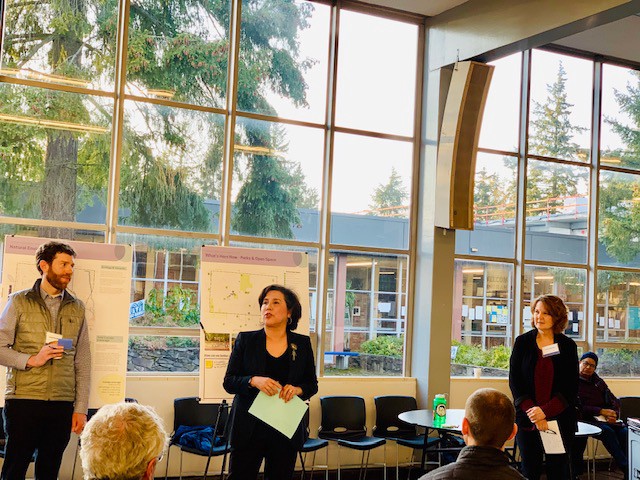
“North Seattle is ready for growth and economic recovery,” Councilmember Juarez said. “This draft plan promises a one-stop shopping and living experience — where you can pick up your child from daycare after work, swing by the grocery store, and take a walk through your neighborhood park on your way home. It’s clear that folks want a more walkable, more connected eco-friendly way-of-life, and this draft plan is our blueprint for making it a reality.”
What buildings are allowed now and likely in rezoning?
While there aren’t any major business districts or urban villages in the immediate vicinity of either light rail station, there are a few clusters of multifamily zoning. The current zoning map shows some Midrise zoning east of 12th Avenue NE opposite the golf course and a small band of Neighborhood Commercial 55 with Lowrise zoning near Roosevelt Way and 10th Avenue NE. Some of the single-family homes near the golf course are luxurious and valued in excess of one million dollars, but other parts of the study area still hold onto their working class roots.
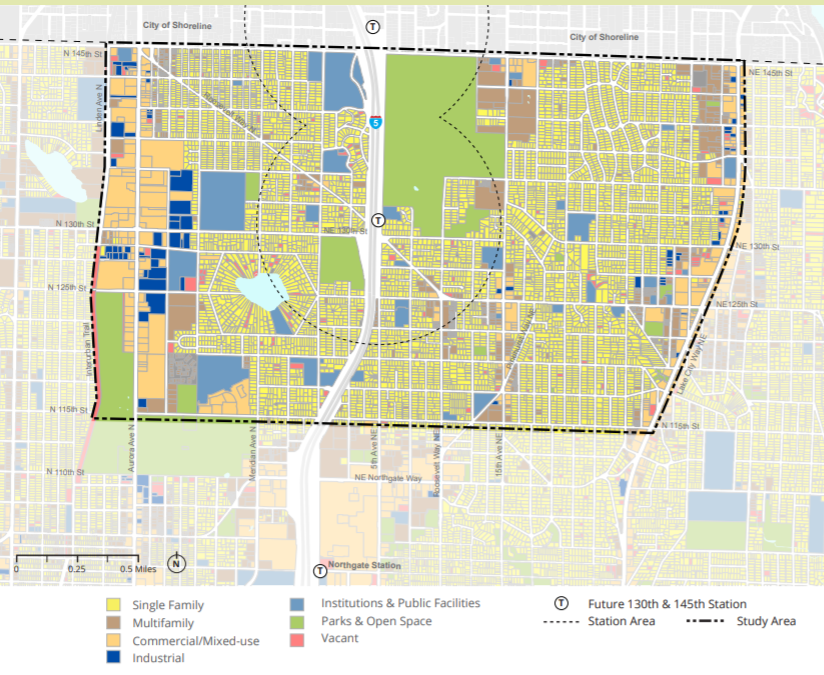
“I’ve been organizing in Pinehurst for over 20 years and this neighborhood has been a community of largely modest income people and many thriving immigrant communities,” Staton said. “I’ve watched many longtime friends and neighbors leave due to rent increases or no longer being able to afford upkeep on their homes.”
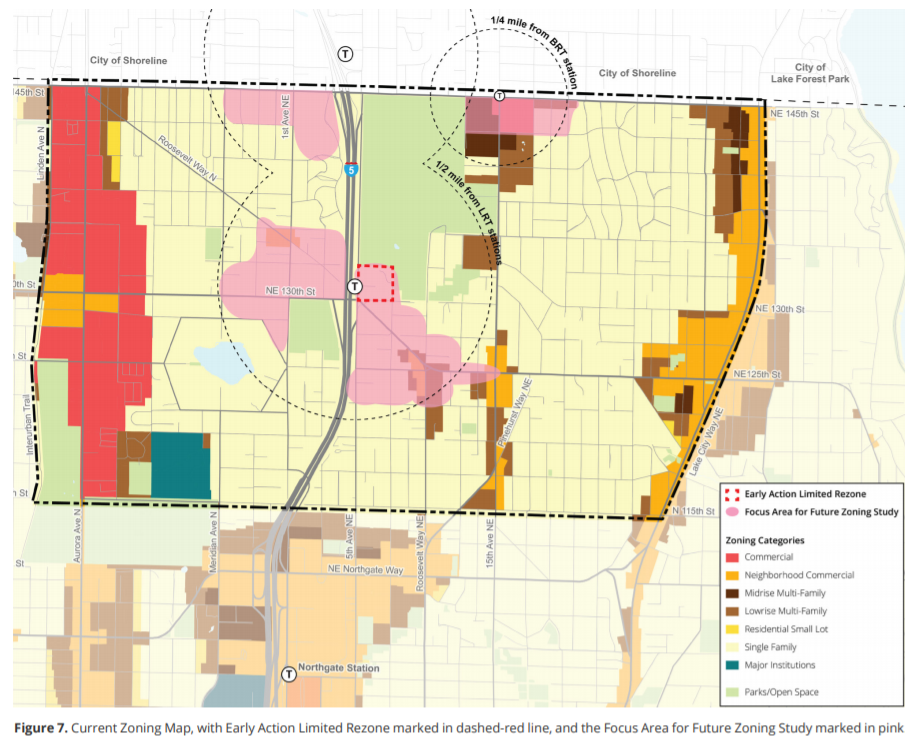
Staton argued that station area plan could unlock social housing investments that could stem displacement from the community.
“We need more subsidized affordable housing in the community as soon as possible,” she added. “I would personally love to see non-profit affordable housing providers engaging now with the community and targeting sites. 15th Ave NE just south of 145th seems a location that would make sense to redevelop now for this as there are large underdeveloped parcels.”

The draft plan highlights the concept of missing middle housing, which ranges from duplexes to small apartment buildings (no larger than 20 units in Opticos Design framework). OPCD still envisions some areas with greater density than that framework.
“There are some larger parcels where certainly we’d like to see redevelopment at higher densities, and again there are some areas that we’ve explored with the community already where we want to see retail at street level,” Carroll said. “We’re not going to see retail everywhere along those east-west corridors, but the places where it’s important, and people certainly zeroed in on 5th Avenue right across from the station.”
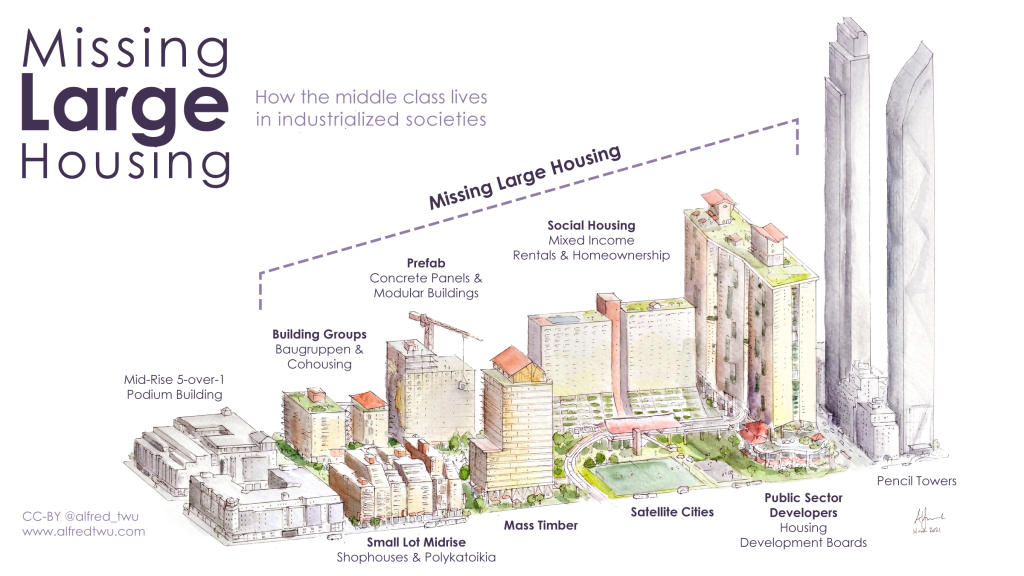
Alfred Twu’s Missing Large Housing concept may offer some opportunities for Seattle to increase retail and access to these stations and makes the case that retail density could be higher thanks to housing density.
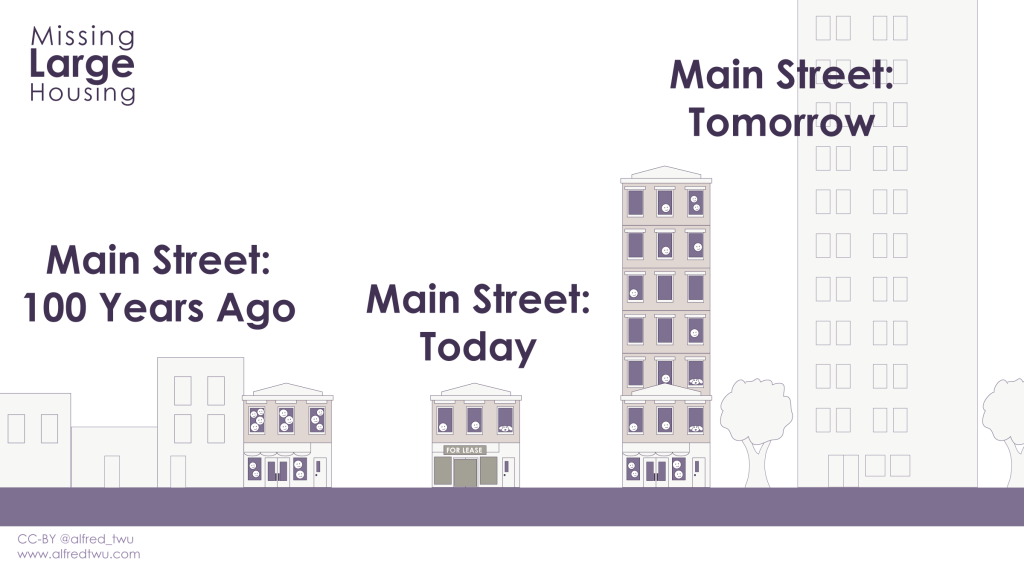
The existing patches of Midrise zoning in the area have yet to be redeveloped, though they already host older lowrise apartment buildings hemmed in by the golf course to the west and busy 145th Street to the north. Carroll suggests housing demand in the area isn’t yet high enough to support midrise (or highrise) development. However, that could change in a hurry once light rail opens.
OPCD argues there’s still time and that they are not behind schedule for passing zoning changes, even though 148th Street Station will open in 2024 and 130th Street Station could open a year after if advocates succeed in securing an early opening. Seattle is well behind Shoreline, which upzoned the 185th Street Station area in 2015 and around 148th Street Station in 2016 and has seen a wave of apartment development, which Shaun Kuo covered yesterday.
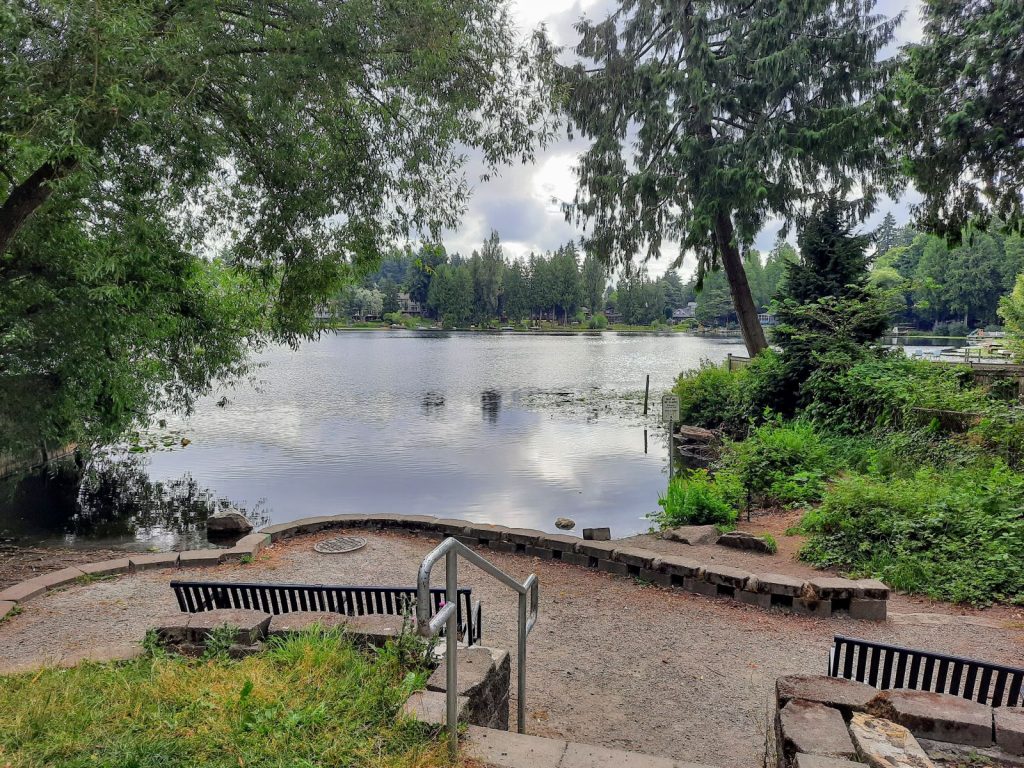
“We usually see a market start to respond to a station about three years before it opens. So that’s why right now you’re seeing a lot of activity in Shoreline. A lot of townhomes getting built around both of their stations,” Carroll said. “The current plan is for 130th Street Station to open in 2031, so the market might start responding in 2028. We have plenty of time to get zoning in place by then.”
“If it opens in 2025 or 2026, I think we’re still on time to get some zoning in place before that early opening could occur,” she added.
The fate of Jackson Park Golf Course
OPCD largely punted on the issue of Jackson Park Golf Course. The perimeter trail around the course is highlighted as a tier one priority project in the mobility plan, but Carroll said the reuse of the course is up to Seattle Parks. The department does have a new strategic plan, she said, and is looking to rethink single use sites (e.g., a massive golf course). It seems like shrinking the size of the golf course to allow some cut through paths (since the fenced off course obstructs both stations’ walksheds), publicly accessible park space, and soccer fields that would be more widely used than a niche sport in golf. City data shows golf is waning in popularity, mostly played by wealthy men, and in need of infusion in public money to support its operations and capital upgrades. Still, OPCD is aware of no specific reuse plans for the golf course, Carroll said.
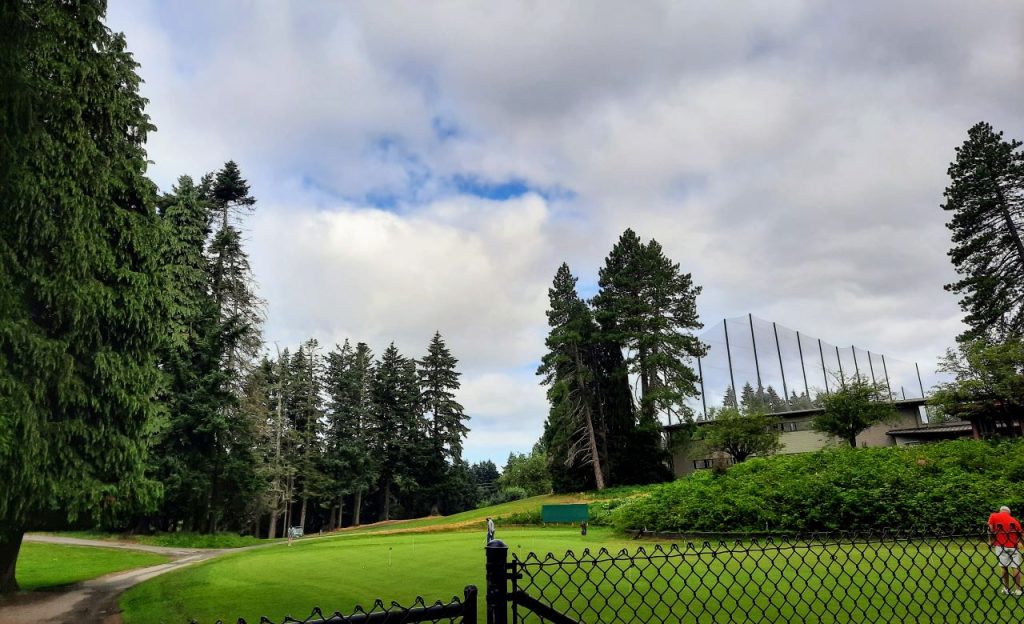
Architect and advocate Ryan DiRaimo has also proposed a more audacious plan to redevelop the golf course with apartment blocks, which would require a change in City law around reusing park space. Thornton Creek goes through the southwestern edge of the golf course and acts as a stormwater management facility operated by Seattle Utilities, Carroll said. The creek watershed is an environmentally critical area, but the rest of the course is not designated as such, Carroll said — not necessarily precluding structures from added.
Renaming Jackson Park Golf Course is also up to Seattle Parks, OPCD said, and didn’t seem to be on their radar. Jackson Park is named the seventh president of the United States, Andrew Jackson, who signed the Indian Removal Act and lead several genocidal campaigns against Indigenous tribes, including the Cherokee Trail of Tears. As such, racism isn’t just baked into the land use and zoning in North Seattle, it’s embedded in the name of the largest public property in the area.
How soon land use and zoning changes happen will likely hinge on whether 130th Street Station opens nearly concurrently with the rest of Lynnwood Link in 2025, in 2031, or later. The Urbanist has urged Sound Transit to move up the station opening date, and hopefully the Sound Transit Board can put together a budget to make that work.
OPCD is welcoming comments on the draft plan via an online survey or via email. Email a letter or comments to patrice.carroll@seattle.gov.
Doug Trumm is publisher of The Urbanist. An Urbanist writer since 2015, he dreams of pedestrian streets, bus lanes, and a mass-timber building spree to end our housing crisis. He graduated from the Evans School of Public Policy and Governance at the University of Washington in 2019. He lives in Seattle's Fremont neighborhood and loves to explore the city by foot and by bike.

